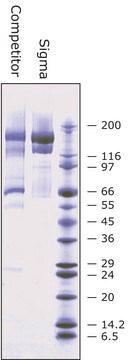M6514
3-(Trimethoxysilyl)propyl methacrylate
≥97%
Synonyme(s) :
Silane A174, [3-(Methacryloyloxy)propyl]trimethoxysilane
About This Item
Produits recommandés
Pureté
≥97%
Forme
liquid
Indice de réfraction
n20/D 1.431 (lit.)
Point d'ébullition
190 °C (lit.)
Densité
1.045 g/mL at 25 °C (lit.)
Température de stockage
2-8°C
Chaîne SMILES
CO[Si](CCCOC(=O)C(C)=C)(OC)OC
InChI
1S/C10H20O5Si/c1-9(2)10(11)15-7-6-8-16(12-3,13-4)14-5/h1,6-8H2,2-5H3
Clé InChI
XDLMVUHYZWKMMD-UHFFFAOYSA-N
Vous recherchez des produits similaires ? Visite Guide de comparaison des produits
Description générale
Application
- Isoelectric focusing can lead to pH gradient formation resulting in the swelling or shrinking of gel casts. This can be prevented by using 3-(Trimethoxysilyl)propyl methacrylate to link polyacrylamide gels to glass plates covalently.
- In situ hybridization using 3-(Trimethoxysilyl)propyl methacrylate along with poly-L-lysine is a faster and durable method to attach cells, microscopic sections, and total organs to slides/other glass surfaces.
- 3-(Trimethoxysilyl)propyl methacrylate is also used in the preparation of organic/inorganic hybrid nanomaterials.
Conditionnement
Produit(s) apparenté(s)
Code de la classe de stockage
10 - Combustible liquids
Classe de danger pour l'eau (WGK)
WGK 1
Point d'éclair (°F)
197.6 °F - closed cup
Point d'éclair (°C)
92 °C - closed cup
Équipement de protection individuelle
Eyeshields, Gloves, type ABEK (EN14387) respirator filter
Certificats d'analyse (COA)
Recherchez un Certificats d'analyse (COA) en saisissant le numéro de lot du produit. Les numéros de lot figurent sur l'étiquette du produit après les mots "Lot" ou "Batch".
Déjà en possession de ce produit ?
Retrouvez la documentation relative aux produits que vous avez récemment achetés dans la Bibliothèque de documents.
Les clients ont également consulté
Notre équipe de scientifiques dispose d'une expérience dans tous les secteurs de la recherche, notamment en sciences de la vie, science des matériaux, synthèse chimique, chromatographie, analyse et dans de nombreux autres domaines..
Contacter notre Service technique






![3-[Tris(trimethylsiloxy)silyl]propyl methacrylate contains MEHQ + HQ as stabilizer, 98%](/deepweb/assets/sigmaaldrich/product/structures/148/664/33ff5116-f264-4a64-824a-009c2ca5b2b3/640/33ff5116-f264-4a64-824a-009c2ca5b2b3.png)


